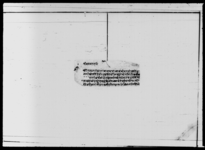A purjī from Garuḍadhvaja Pā̃ḍe ordering the provision of wheat to Viramardana (VS 1878)
ID: E_2778_0003
Edited and
translated by Surabhi Pudasaini
in collaboration with
Pabitra Bajracharya
Created: 2022-07-18;
Last modified: 2022-12-31
For the metadata of the document, click here
The accompanying edition, translation/synopsis and/or commentary are available under the terms of the Creative Commons Attribution-ShareAlike 4.0 International License
Abstract
This purjī from the kaparadāra Garuḍadhvaja Pā̃ḍe orders the aḍais Rājabala Ḍoṭyāla and Ramānātha Pādhyā to provide wheat to Viramardana, son of Dharmā.Diplomatic edition
[1r]
1⟪३⟫1⟪[?]⟫1श्री\1श्रीवडामहारानि1अडैराजवलडोट्यालरमानाथपाध्याकेश्रीकपर्दारगरुडध्व2जपाडेकोपुर्जिऊप्रांतलुभुसेराको७८सालकोगहुंवालिमध्ये१
3¯ ¯ ¯कापटीधर्माकोछोराविरमर्दनकोनाऊमाएकछामात्रफर्द
4माचह्र्याकोछगरेएकछाकमात्रभन्याफेरिगहुंपाथी१५भरि
5देउवहिवुझदामौजरापर्लाइतिसम्वत१८९८सालभादौवदि१४
Translation
[1r]
3
...
Śrī Baḍā Mahārāni
To Aḍais Rājabala Ḍoṭyāla [and] Ramānātha Pādhyā
A purjī from ŚrīKaparadāraGaruḍadhvaja Pāḍe
Uprānta: From the wheat crop (bālī) of the year 78 from the [lands comprising the] Lubhuserā, apparently only one meal is given [recorded] in the list (pharda) under the name of Viramardana, the son of Dharmā, who serves the eldest queen. If it is [indeed] only one meal, again disburse (bhari deū) 15 pāthīs of wheat. When the accounts are cleared, a deduction will be granted.
The 14th of the dark fortnight of Bhādau in the [Vikrama] era year 1878 (1821 CE). May it be auspicious.
Commentary
This is a note from the kaparadāra Garuḍadhvaja Pā̃ḍe ordering two aḍais to provide wheat to Viramardana, son of Dharmā, a servant attached to the senior queen. It indicates that the kaparadāra’s office kept a list (pharda) of the servants who were to receive grains. This list recorded whether the recipients were given grains for one or two daily meals. According to the list, Viramardana had only been receiving one meal. In adding 15 pāthīs to Viramardana, the kaparadāra was upgrading his allowance to two daily meals.
This is one of ten documents (E_2778_0001 to E_2778_0010) recording the distribution of wheat to various people who worked within the Hanumānḍhokā palace complex. All the orders date to VS 1878 (1821 CE) and relate to the wheat crop of Lubhu serā land in that year.
Savāla 3 of RRC_0024_0776, laying out Bhoṭu Pā̃ḍe’s duties as kaparadāra in VS 1859, confirms that the kaparadāra was responsible for ascertaining the amount of foodgrains that palace servants received. Garuḍadhvaja Pā̃ḍe appears to be fulfilling that duty here. The ten directives were issued over the course of three months from Jeṭh to Bhadau. Ascertaining the amount of foodgrains that individual palace servants received was, therefore, not a task concluded in parallel. Rather, the amounts were reviewed and confirmed serially.
Garuḍadhvaja was kaparadāra from the early VS 1870s till the early 1890s. He was a son of the former kaparadāra Bhoṭu Pā̃ḍe (see Pā̃de Chetrī 1977: 246). Though the authority to ascertain amounts rested with the kaparadāra, the orders were carried out by two aḍais, Rājabala Ḍoṭyāla and Ramānātha Pādhyā. Aḍais were employed at the Koṭa Bhaṇḍāra, which managed the stores of foodstuffs within the royal palace complex. Each serā was also put under the management of one or a pair of aḍais.1 Outside the current ten documents, Rājabala Ḍoṭyāla appears again in relation to Lubhu serā [land] in VS 1880 in E_2764_0046.

